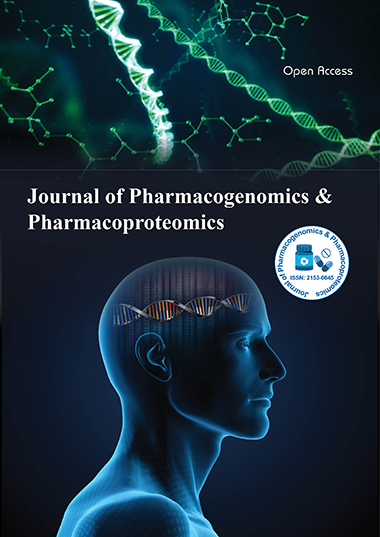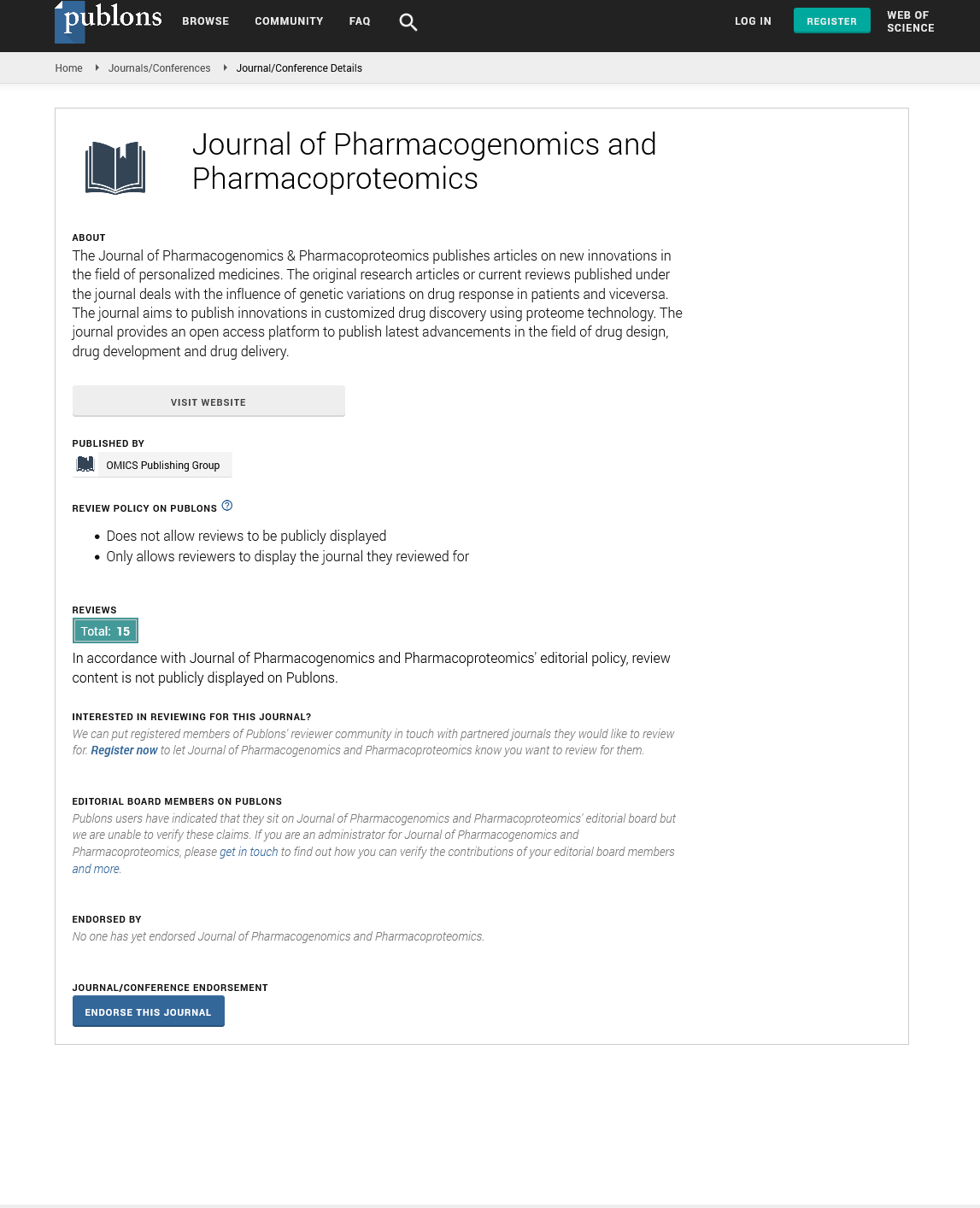Indexed In
- Open J Gate
- Genamics JournalSeek
- Academic Keys
- JournalTOCs
- ResearchBible
- Electronic Journals Library
- RefSeek
- Hamdard University
- EBSCO A-Z
- OCLC- WorldCat
- Proquest Summons
- SWB online catalog
- Virtual Library of Biology (vifabio)
- Publons
- MIAR
- Euro Pub
- Google Scholar
Useful Links
Share This Page
Journal Flyer

Open Access Journals
- Agri and Aquaculture
- Biochemistry
- Bioinformatics & Systems Biology
- Business & Management
- Chemistry
- Clinical Sciences
- Engineering
- Food & Nutrition
- General Science
- Genetics & Molecular Biology
- Immunology & Microbiology
- Medical Sciences
- Neuroscience & Psychology
- Nursing & Health Care
- Pharmaceutical Sciences
Commentary - (2024) Volume 15, Issue 4
Epigenetic Mechanisms in Health Therapeutic Development and Innovations in Medicine: Phenotypic Diversity Analysis
Received: 25-Nov-2024, Manuscript No. JPP-24-27901; Editor assigned: 29-Nov-2024, Pre QC No. JPP-24-27901 (PQ); Reviewed: 16-Dec-2024, QC No. JPP-24-27901; Revised: 24-Dec-2024, Manuscript No. JPP-24-27901 (R); Published: 31-Dec-2024, DOI: 10.35248/2153-0645.24.15.113
Description
Clinical epigenetics, the study of heritable changes in gene expression that do not involve alterations to the DNA sequence, has emerged as a critical area in understanding complex biological systems and diseases. These modifications include DNA methylation, histone modification and non-coding RNAs, which play pivotal roles in gene regulation. Epigenetics intersects significantly with drug discovery and the study of genomics and phenotypic diversity, offering novel avenues for therapeutic interventions and insights into biological complexity. The dual themes of epigenetics in drug discovery and its role in bridging genomics with phenotypic diversity. It highlights recent advancements, challenges and future prospects in these domains. Epigenetic modifications regulate gene expression patterns and maintain cellular identity. Deregulations of these mechanisms can lead to diseases such as cancer, neurodegenerative disorders and autoimmune diseases. Identifying these aberrant modifications provides a basis for targeting them in drug discovery.
DNA Methyltransferases (DNMTs) enzymes that add methyl groups to cytosine in DNA. Aberrant DNA methylation is a hallmark of many cancers, making DNMT inhibitors such as azacitidine and decitabine effective in treating myelodysplastic syndromes and acute myeloid leukemia. Histone Deacetylases (HDACs) enzymes that remove acetyl groups from histones, leading to chromatin condensation and transcriptional repression. HDAC inhibitors like vorinostat and romidepsin have been approved for treating cutaneous T-cell lymphoma. Bromodomain and Extra-Terminal Domain (BET) proteins that recognize acetylated lysines on histones and facilitate transcription. BET inhibitors are under investigation for treating cancers and inflammatory diseases.
Technological innovations such as CRISPR/Cas9-mediated epigenomics editing and high-throughput sequencing have revolutionized epigenetic drug discovery. These tools enable precise modification of epigenetic marks, facilitating the development of drugs with higher specificity and reduced offtarget effects. For instance, targeted epigenome editing using CRISPR-dCas9 fused with DNMT or HDAC domains allows the modulation of specific genes associated with disease states. Additionally, single-cell epigenomics provides insights into cellspecific epigenetic alterations, aiding in the identification of novel therapeutic targets. Epigenetic drugs often target ubiquitous enzymes, risking unintended effects on normal cells. The reversible nature of epigenetic modifications can lead to resistance and relapse in treated patients. Efficient and targeted delivery of epigenetic drugs to specific tissues remains a hurdle. Phenotypic diversity, the observable variations among individuals, arises from the interaction of genetic and epigenetic factors. While genomics provides the blueprint of an organism, epigenetics modulates how this blueprint is read, resulting in diverse phenotypes even among genetically identical individuals. Monozygotic twins exhibit phenotypic differences despite sharing identical DNA sequences. These differences are attributed to epigenetic variations influenced by environmental factors, lifestyle and stochastic events.
Epigenetic mechanisms contribute to evolution and adaptation by enabling organisms to respond rapidly to environmental changes without altering their genetic code. Epigenetic inheritance allows traits acquired during an individual’s lifetime to be passed to offspring, providing a mechanism for rapid adaptation. This is evident in plants, where stress-induced epigenetic changes enhance resilience and are transmitted across generations. Advances in epigenomics technologies have facilitated the exploration of phenotypic diversity. Highresolution techniques such as ChIP-seq, ATAC-seq and single-cell RNA-seq reveal cell-type-specific epigenetic landscapes, providing insights into how epigenetic modifications drive phenotypic variation.
Moreover, population epigenomics, which examines epigenetic variations across populations, sheds light on how environmental and genetic factors interact to shape phenotypic traits. This is particularly relevant in understanding health disparities, where epigenetic modifications influenced by socioeconomic and environmental factors contribute to differential disease risks among populations. The convergence of epigenetics with genomics and phenotypic diversity has profound implications for precision medicine. Epigenetic profiling enables the identification of biomarkers for disease diagnosis, prognosis and therapeutic response prediction. For instance, hyper methylation of the MGMT promoter serves as a predictive biomarker for glioblastoma patients undergoing alkylating agent chemotherapy. Epigenetic therapies tailored to an individual’s epigenetic landscape hold promise for achieving personalized treatment. Advances in artificial intelligence and machine learning are enhancing the ability to integrate multi-Omics data, paving the way for epigenomics-driven precision medicine.
Integrating epigenetics with transcriptomics, proteomics and metabolomics will provide a holistic understanding of biological systems. Multi-Omics approaches can uncover complex interactions between genetic and epigenetic factors, facilitating the discovery of novel therapeutic targets and strategies. The development of more precise and efficient tools for epigenome editing, such as base editors and prime editors, will enhance the ability to modulate specific epigenetic marks. These tools will also enable the study of epigenetic mechanisms in a more controlled manner, advancing both basic and translational research. As epigenetic therapies move toward clinical application, addressing ethical and regulatory challenges will be important. Issues such as long-term effects, epigenetic inheritance and equitable access to epigenetic therapies need careful consideration to ensure their safe and effective use. Epigenetics serves as a critical bridge between genomics and phenotypic diversity, providing insights into the mechanisms underlying biological complexity. Its role in drug discovery has already transformed the therapeutic landscape, offering novel approaches for treating diseases with epigenetic underpinnings. The integration of epigenetics into precision medicine and multi- Omics approaches holds immense promise for advancing healthcare. As technologies and methodologies continue to evolve, the potential of epigenetics in resolving the mysteries of gene regulation and phenotypic diversity will expand, driving innovation in both basic research and clinical practice.
Citation: Derui Q (2024). Epigenetic Mechanisms in Health Therapeutic Development and Innovations in Medicine: Phenotypic Diversity Analysis. J Pharmacogenom Pharmacoproteomics. 15:113.
Copyright: © 2024 Derui Q. This is an open-access article distributed under the terms of the Creative Commons Attribution License, which permits unrestricted use, distribution, and reproduction in any medium, provided the original author and source are credited.

